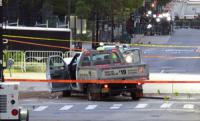-
Israeli air strike destroys Iranian missile production, storage facility in Syria

Satellite images released Sunday by ImageSat International (ISI) showed the impact of an airstrike, blamed on Israel, on a missile base in Syria on Saturday evening that reportedly killed Iranian personnel. Israeli analysts say that recent Israeli air strikes in Syria probably would not have passed without public Russian comment had Israel and Russia not reached an understanding designed to reduce possible friction and improve early warning between Israeli and Russian armed forces operating in Syria.
-
-
Weapons of mass distraction
A sobering new report from the U.S. Department of State’s Global Engagement Center details the reach, scope, and effectiveness of Russia’s disinformation campaigns to undermine and weaken Western societies. “The messages conveyed through disinformation range from biased half-truths to conspiracy theories to outright lies. The intent is to manipulate popular opinion to sway policy or inhibit action by creating division and blurring the truth among the target population,” write the authors of the report.
-
-
U.K. citizens prohibited from traveling to, remaining in designated terrorist areas
British Home Secretary Sajid Javid said that British citizens who travel to overseas terrorism areas will face up to ten years in jail under new laws, which come into effect today. The legislation targets potential foreign fighters, and making it a punishable offense to enter or remain in a “designated area.”
-
-
German police raids Hamas-linked charities

The German police have staged raids across Germany, targeting charities which provide support to the Palestinian Hamas movement in the Gaza Strip. The United States, Israel, and the EU regard Hamas a terrorist organization.
-
-
Islamic State: the “caliphate” is off the map for now, but will evolve in dangerous ways
The so-called Islamic State (IS) recently lost its last remnant of territory in Syria, but observers were quick to remind the world that the war against the organization is far from over. IS is now expected to evolve, but with its defeat on the ground in Syria and Iraq, IS and its offshoots will have a more limited capacity for recruitment, indoctrination and growth.
-
-
China catching up to the U.S. in innovation
If China is only a copier, not an innovator, then the competitive threat it poses to advanced economies would be limited. But there is no reason to believe China won’t follow the path of “Asian tigers” that rapidly evolved from copiers to innovators, which poses a serious threat.
-
-
Police foil possible terror truck attack outside Washington, D.C.

A Maryland man has been arrested for an Islamic State-inspired terror plot to run down pedestrians with a stolen truck. Federal prosecutors will argue in a court appearance Tuesday that 28-year-old Rondell Henry should remain in detention pending trial.
-
-
Foiled terrorist plot targeted Colombia's president
The Colombian government said that armed groups were plotting an attack against President Ivan Duque. The attorney general said the alleged scheme involved “a high-precision weapon.” The Colombian authorities are investigating the militant plan to target Duque during a scheduled meeting with indigenous communities on Tuesday.
-
-
Hate incidents are underreported. Now, there’s an app for that
Despite the FBI recording an all-time high in hate-motivated incidents in 2017 (the most recent year’s statistics available) the number is likely much higher. Low reporting from victims to police and inconsistent reporting from police to federal authorities have created a massive gap in how we understand hate in America. Researchers from the University of Utah want to fill that gap with an app.
-
-
U.S. Homeland Security secretary Kirstjen Nielsen resigns
U.S. Department of Homeland Security Secretary Kirstjen Nielsen has resigned after 16 months on the job and immense pressure from the White House and public over the situation along the country’s southern border. Nielsen said later on Twitter her last day on the job will be Wednesday.
-
-
U.S. designates Iran's Revolutionary Guards as “foreign terrorist organization”
The United States has designated Iran’s Revolutionary Guards Corps (IRGC) a foreign terrorist organization. The U.S. currently designates some sixty groups around the world as foreign terrorist organizations, but none of them is a state-run military like the IRGC.
-
-
Countering violent extremism (CVE): Which programs work, and why
As countries around the world develop countering violent extremism (CVE) programs to prevent homegrown terrorism, there is a dearth of understanding about what types of such programs exist and which approaches are most effective.
-
-
U.S. industries turn to feds for help in economic race with China
In the U.S. economic battle with China, the Chinese government is often portrayed as a kingmaker, making large investments in research and paving the way for Chinese companies to thrive. China, it turns out, is a good foil for U.S. industries as they ask the U.S. government to do more to help them compete globally.
-
-
Online voting not ready for prime time
Online voting is often considered a way to improve voter turnout and security. But according to one expert, computer scientists have got a long way to go before they make it a viable alternative to pencils and paper.
-
-
AfD Bunestag member under Russian influence: Report
Markus Frohnmaier, an MP for the far-right, populist AfD party, could be controlled by Russia, several European media outlets have reported. Frohnmaier has publicly sided with Moscow on practically each and every issue important to Vladimir Putin. The investigative report – the result of a joint effort by several leading European news organizations – concluded that Frohnmaier “stands under the influence of Moscow” and that his political and legislative actions aim to further Russia’s strategic interests.
-
More headlines
The long view
Factories First: Winning the Drone War Before It Starts
Wars are won by factories before they are won on the battlefield,Martin C. Feldmann writes, noting that the United States lacks the manufacturing depth for the coming drone age. Rectifying this situation “will take far more than procurement tweaks,” Feldmann writes. “It demands a national-level, wartime-scale industrial mobilization.”
No Nation Is an Island: The Dangers of Modern U.S. Isolationism
The resurgence of isolationist sentiment in American politics is understandable but misguided. While the desire to refocus on domestic renewal is justified, retreating from the world will not bring the security, prosperity, or sovereignty that its proponents promise. On the contrary, it invites instability, diminishes U.S. influence, and erodes the democratic order the U.S. helped forge.
Fragmented by Design: USAID’s Dismantling and the Future of American Foreign Aid
The Trump administration launched an aggressive restructuring of U.S. foreign aid, effectively dismantling the United States Agency for International Development (USAID). The humanitarian and geopolitical fallout of the demise of USAID includes shuttered clinics, destroyed food aid, and China’s growing influence in the global south. This new era of American soft power will determine how, and whether, the U.S. continues to lead in global development.
Water Wars: A Historic Agreement Between Mexico and US Is Ramping Up Border Tension
As climate change drives rising temperatures and changes in rainfall, Mexico and the US are in the middle of a conflict over water, putting an additional strain on their relationship. Partly due to constant droughts, Mexico has struggled to maintain its water deliveries for much of the last 25 years, deliveries to which it is obligated by a 1944 water-sharing agreement between the two countries.
How Disastrous Was the Trump-Putin Meeting?
In Alaska, Trump got played by Putin. Therefore, Steven Pifer writes, the European leaders and Zelensky have to “diplomatically offer suggestions to walk Trump back from a position that he does not appear to understand would be bad for Ukraine, bad for Europe, and bad for American interests. And they have to do so without setting off an explosion that could disrupt U.S.-Ukrainian and U.S.-European relations—all to the delight of Putin and the Kremlin.”
How Male Grievance Fuels Radicalization and Extremist Violence
Social extremism is evolving in reach and form. While traditional racial supremacy ideologies remain, contemporary movements are now often fueled by something more personal and emotionally resonant: male grievance.
